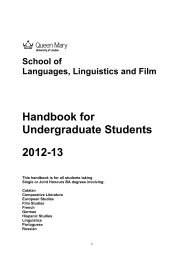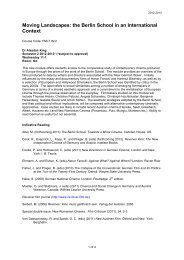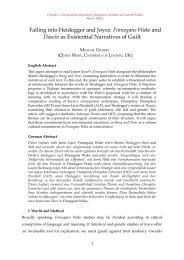Create successful ePaper yourself
Turn your PDF publications into a flip-book with our unique Google optimized e-Paper software.
eTransfers. A Postgraduate eJournal for Comparative Literature and Cultural Studies<br />
Issue 1 (2011)<br />
his troubled emotional state. One might even say that the memory trace embodies it-<br />
self in Perowne’s involuntarily trembling fingers. During his opening conversation<br />
with Strauss, Perowne does not mention that he was held up by a row in the street:<br />
“He doesn’t want to hear himself describe Baxter and his friends. They’ll interest<br />
Strauss too much, and prompt questions he doesn’t feel like answering yet” (S 102).<br />
This is a clear incident of what the sociologist Erving Goffman calls the ‘management<br />
of identity’: 26 in order to preserve one’s own self-image, an individual generally care-<br />
fully plans which parts of her or his actions are revealed to whom and how far one<br />
lets the other look into one’s own identity. The quoted passage continues: “He’s<br />
already feeling a rising unease about the encounter, a disquiet he can’t yet define,<br />
though guilt is certainly an element” (S 102).<br />
The narrating instance makes the reader privy to several interlinked processes<br />
running simultaneously in Perowne’s head: his unease is a temporally extended<br />
emotion that is caused not by an interior bodily process but by a complex interplay<br />
between an individual memory of individual actions and the thought of what society<br />
would have said about these actions had there been any witnesses. In other words,<br />
the memory of the events is compared to social norms that have been internalised by<br />
the individual, in turn causing certain feelings and emotions. Several aspects that are<br />
emphasised by situated approaches to cognition are manifest in this passage. First of<br />
all, the cognitive processes going on in Perowne’s head are situated in a social con-<br />
text and are very much connected to his body. After all, remaining bodily unharmed<br />
was the initial motivation for his actions in the post-accident episode and his body<br />
reacts clearly towards the stressful situation. At the same time, the cognitive pro-<br />
cesses going on in Perowne’s mind could only have occurred in this concrete situ-<br />
ation and in this particular location. In short, cognition is represented as being en-<br />
gaged and specific.<br />
Perowne’s moral musings also result in a cleft between his actions and his cognit-<br />
ive processes: what he really wants to do is think through the post-accident episode<br />
but what he actually does is put on his goggles to begin the game (S 102). His aware-<br />
26 Cf. Erving Goffman, Stigma. Notes on the Management of Spoiled Identity (Englewood Cliffs, NJ: Pren-<br />
tice-Hall, 1963).<br />
15







